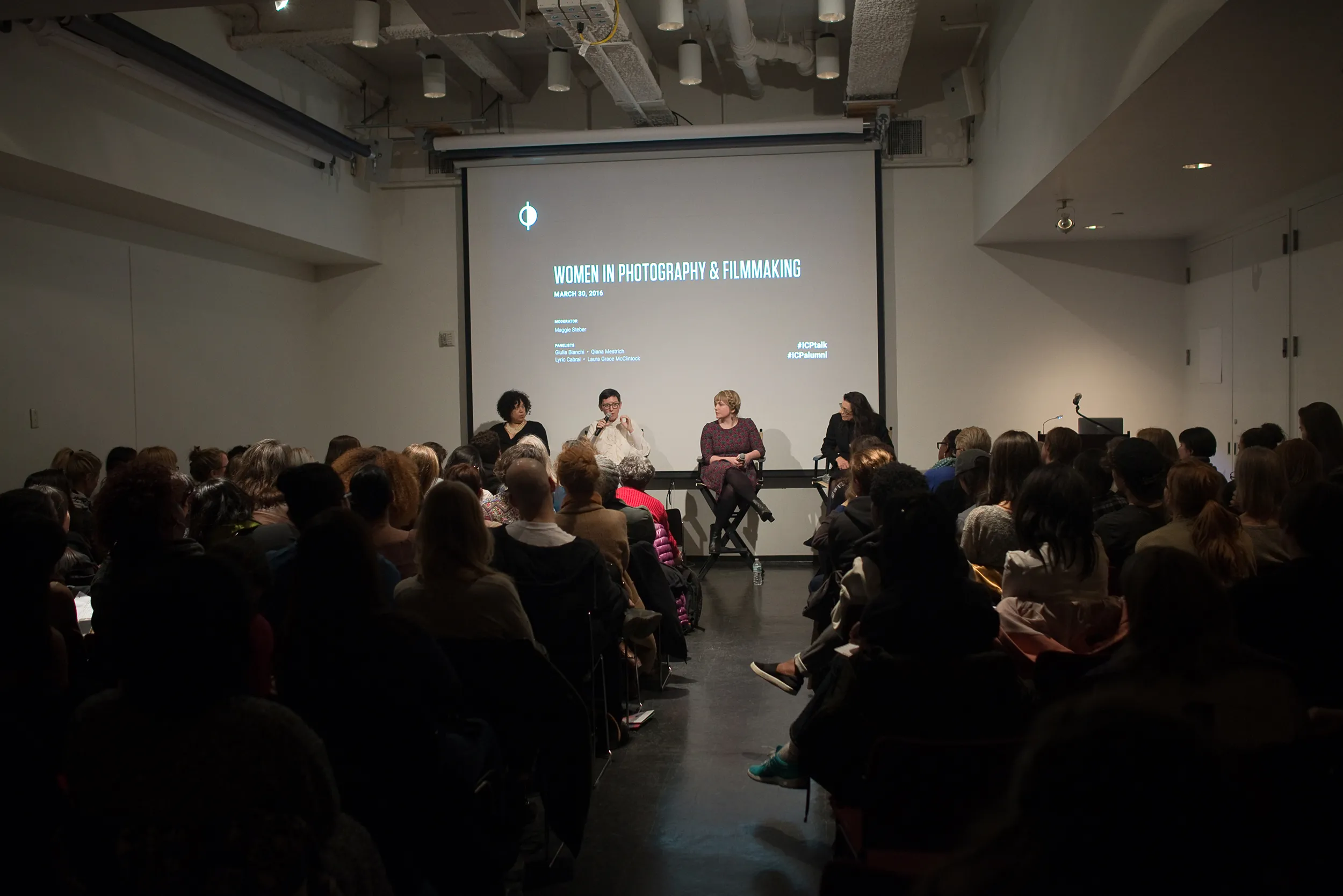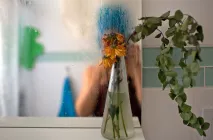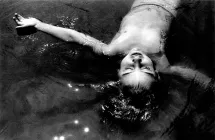On March 30, 2016, the ICP hosted a panel discussion, moderated by Maggie Steber, with four women photographers and filmmakers. The panel included Giulia Bianchi, Lyric Cabral1, Laura McClintock, and Qiana Mestrich. Steber began the conversation by hinting at how “lonely it can be to try to find your voice in a male dominated environment,” and as the panel progressed, it became clear that different generations have different coping mechanisms for the gender injustice that exists in these fields.
As someone who has taught workshops at ICP for the last 20 years, Steber said she expected this conversation to have “happened a long time ago,” and been “resolved.” But then Steber asked, “How many people here know who Catherine Leroy was?” A handful of hands went up in a mostly silent crowd. “Who ever heard of Christine Spengler?” From the back of the room emerged an enthusiastic voice, asserting that Spengler is among the living and still working.
“Everybody lives under a male narrative, men describe everything,” said Steber. “During one interview...a male interviewer asked me about having children, and I said 'Wait a minute, stop right there, do you ever ask men photographers this question?' He said no, because usually it's the women taking care of the children.’” This topic, despite being relevant and valid, is one of many, many strings within the social matrix that affects how women move through the photography and filmmaking industries.
Despite the steadily increasing numbers of women in photography over the last three decades, parity remains distant. In a 2015 study, Onward collected data on members of the Association of International Photography Art Dealers (AIPAD) and found that women occupied 20 percent of the field. Last November, the New York Times published Women of Hollywood Speak Out, a survey of the current struggles of women in Hollywood. Lena Dunham is quoted as having said, “Women shouldn’t be having to hustle twice as fast to get what men achieve just by showing up.’’ In the June 2015 issue of ARTNews, Cindy Sherman shared a similar observation: “I have always sensed that women artists [sic] have to prove themselves exceptional in order to get their foot in the door...whereas many, many mediocre men artists [sic] easily get by.”
ARTNews dedicated its June 2015 issue to women in the art world. In 1971, ARTNews famously published Linda Nochlin's “Why Have There Been No Great Women Artists?” a piece that framed “the question of women’s equality” as one that depends “on the very nature of our institutional structures themselves and the view of reality which they impose on the human beings who are part of them.” I thought of Sherman's words as McClintock shared one teacher's remarks that he was “not really interested in beautiful photos,” in reference to her portfolio. In the dominant, heteronormative reading of women’s social value, making beautiful photographs is a drawback only if you are a woman. A male photographer making beautiful pictures would be unquestionably called, “art.”
As someone who has worked as a photo editor and director, as well as a portfolio reviewer, I always notice how often men will describe the work of a female photographer as “beautiful,” regardless of subject matter. It could be a gory photo, but if an attractive woman took the shot, it would be a demeaned as merely a “beautiful photograph.” The undercurrent there is that because a woman made it, it has no value beyond appearance. This transfer of desire from the sexualized body to the work is something I have seen and heard, over and over. Male-presenting female photographers are treated differently. They are seen as more “male” and therefore more capable, despite having the burden of unhinging masculinity from the male body. Whether you are considered beautiful or gender transgressive, being female means being automatically met with a variety of challenges magnified by race, class, education, and especially, body type.
The members of the panel all work with social issues that describe how women are treated by society. McClintock presented a selection of images from a series titled “Hallowed Ground,” based on the still unapprehended and unidentified Long Island serial killer whose murders span back twenty years, but whose victims were only found in 2010. “One of the biggest key points to this story was that all the women were escorts and prostitutes who worked off the back page of Craigslist,” said McClintock. “I think that is why people lost interest very quickly.” Aside from wanting to “advocate for people who couldn't advocate anymore,” McClintock also alluded to the systemic cycles of sexism that plague the most socially fragile among us: “At a press conference to talk about the finding of their remains, one of the head police chiefs was recorded as saying 'Gee, this is a big turn-out for a whore.' That is enough to make work like this,” said McClintock, in reference to her images.
The issues surrounding how women navigate their professional lives in male-dominated fields are not easy to discuss. Steber uses her position to advance the work of younger female photographers, and spoke of her experiences with clarity. One experience Steber described was harrowing. She described having a TV crew camera man arrive later than her on set, then demand that she move so he could take her spot. Steber refused, she was on an assignment too and had arrived first. The camera man physically pushed her head down, twice, trying to force her to move. She didn't (another photographer, male, came and stuck up for her). This combination of male entitlement, bias/judgment, and violence is all too common — it was not the first, or the tenth, time I've heard stories of physical violence toward a female photographer.
The panel took a different but fortifying tone with Giulia Bianchi, a photographer and writer who makes work about the intersection of spirituality and feminism. Currently working on a project about the realities and controversies of women who become ordained as priests, Bianchi framed the discussion through the structural abuses of power that happen when being female is an automatic threat. Although all people who participate in the ordination of a female priest are excommunicated, Bianchi added, “the 6,500 catholic priests who have sexually abused 17,000 children since 1950 have not been excommunicated.”
Locating the issue of inequality as part of a larger social structure, Bianchi read some powerful statistics from a recent United Nations study: “One in the five in the world have been sexually abused as children; 250 million women alive today have undergone genital mutilation; 10,000 child brides are forced to marry every day; and millions of girls are missing as a result of infanticide.”
Qiana Mestrich presented a selection of images from her latest book, Hard to Place, about a mixed race boy growing up in London, who bounced from foster home to foster home. Part of a larger investigation on the history and narratives of mixed race conditions, Mestrich noted that, “because of the stress of discrimination from society, [mixed race] children bear the intolerable weight of their parents' failed love, and of mankind's unsettled history with race.” Giving shape and form to taboo topics, Mestrich and Bianchi's presentations pointed to how early in our lives the struggle actually begins: before we are even born.
Wanting to know the panelists' experiences of “being in the field,” a member of the audience stood up and spoke of how she and her colleagues “happen to be young, small-built women, [and] tend to get treated in a way that is very disrespectful from men...when we are just trying to do our job, or tell the story in a very sensitive manner.” She asked if panelists had “any advice to balance that situation when you are being attacked and degraded [while] trying to do your work, and get through that moment.” Steben responded, “Female photographers are an anomaly to some people. You have to make a decision to not let it daunt you.” Mestrich shared her own experiences with male intimidation, and her defiant will to “toughen up” and focus on getting the job done. McClintock described that for her, “It's really great to prove people wrong. To prove that you have the intelligence and ability and all those things that far surpass the way that you look. I get a lot of strength from that.”
It was Bianchi who placed the severity of such common situations into focus: “I don't want to sound too dramatic, but…I want to just to say that there are actual predators inside our field. For me, it's very important tonight to remind you that these people really feed on your fears. And if they go over the limit, there's nothing wrong in taking your tripod and chasing them with it.” The audience clapped uniformly and without reservation. “Protect yourself and protect the people you love. And make sure that you never work with anyone who molested one of your colleagues. This is very important: never work with them. If you're complacent, you're part of the problem.” The audience reacted well to this direct confrontation of how existing gender disparity moves from a position of professional inequity into acts of discrimination.
Mestrich capped off the evening by saying, “There's no way to cover everything tonight, there are so many subtopics within the subject of women in photography. I really hope ICP takes the opportunity to develop [this subject] into a series of talks.” To this, the crowd clapped and shouted in support. Addressing such a difficult topic only left the crowd at this sold-out event more energized. The professional lives of women, and the necessity for taking control of the means of production certainly deserve more avenues for discussion. The general advancement of film and photography professions can only benefit from an abolishment of gatekeepers, and from the perpetuation of social justice that photography and film have been instrumental in advancing.






